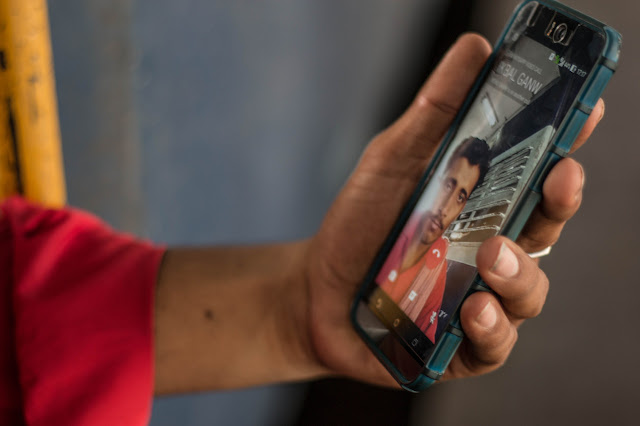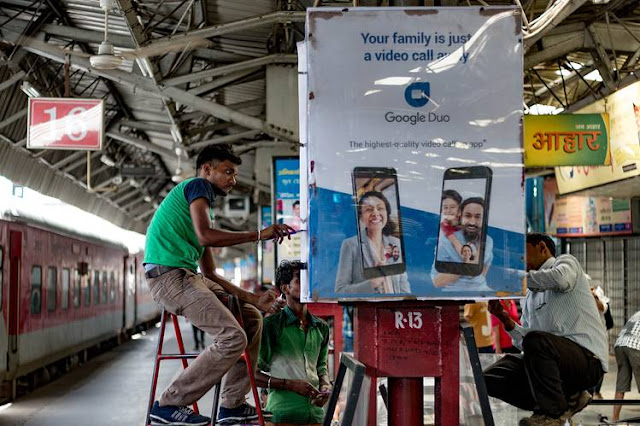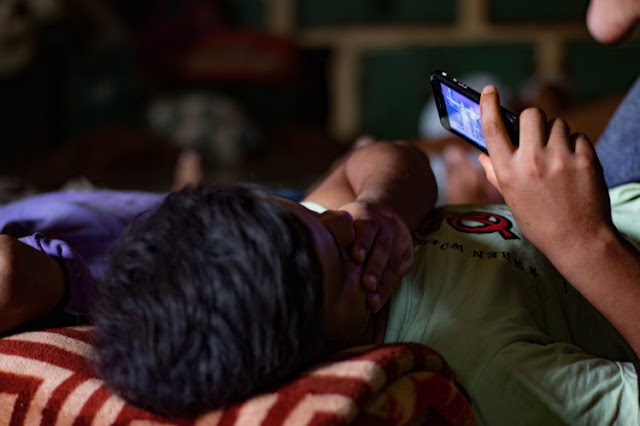THE END OF TYPING: THE NEXT BILLION MOBILE USERS WILL RELY ON VIDEO AND VOICE / THE NEW YORK TIMES
The End of Typing: The Next Billion Mobile Users Will Rely on Video and Voice
Tech companies are rethinking products for the developing world, creating new winners and losers
By Eric Bellman
Photographs by Karan Deep Singh/The Wall Street Journal
The internet’s global expansion is entering a new phase, and it looks decidedly unlike the last one.
Instead of typing searches and emails, a wave of newcomers—“the next billion,” the tech industry calls them—is avoiding text, using voice activation and communicating with images. They are a swath of the world’s less-educated, online for the first time thanks to low-end smartphones, cheap data plans and intuitive apps that let them navigate despite poor literacy.
Incumbent tech companies are finding they must rethink their products for these newcomers and face local competitors that have been quicker to figure them out. “We are seeing a new kind of internet user,” said Ceasar Sengupta, who heads a group at Alphabet Inc.’s Google trying to adapt to the new wave. “The new users are very different from the first billion.”
The Internet's Next Big User Group
https://www.wsj.com/articles/the-end-of-typing-the-internets-next-billion-users-will-use-video-and-voice-1502116070?tesla=y
A look at Megh Singh’s smartphone suggests how the next billion might determine a new set of winners and losers in tech.
Mr. Singh, 36, balances suitcases on his head in New Delhi, earning less than $8 a day as a porter in one of India’s biggest railway stations. He isn’t comfortable reading or using a keyboard. That doesn’t stop him from checking train schedules, messaging family and downloading movies.
“We don’t know anything about emails or even how to send one,” said Mr. Singh, who went online only in the past year. “But we are enjoying the internet to the fullest.”
Mr. Singh squatted under the station stairwell, whispering into his phone using speech recognition on the station’s free Wi-Fi. It is a simple affair, a Sony Corp. model with 4GB of storage, versus the 32GB that is typically considered minimal in the developed world.
On his screen are some of the world’s most popular apps—Google’s search, Facebook Inc.’s WhatsApp—but also many that are unfamiliar in the developed world, including UC Browser, MX Player and SHAREit, that have been tailored for slow connections and skimpy data storage.
Those three apps, not among the top 100 downloads in the U.S., were in India’s top 10 over the 30 months through June, according to App Annie, which tracks apps; many of America’s most popular apps aren’t in India’s top 100.
Mr. Singh’s phone uses Google’s Android operating system, which nearly monopolizes India’s smartphone market in phones from companies such as South Korea’s Samsung Electronics Co. and India’s Micromax Informatics Ltd.
Apple Inc., in contrast, has a 3% smartphone market share in India, estimates market-research firm Kantar Worldpanel, in part because its least expensive iPhone costs over $300; in India, more than 90% of smartphones cost less than that.
Apple declined to comment on its India strategy. During a call with analysts last week, Apple Chief Executive Tim Cook said he was “very, very bullish and very, very optimistic about India.”
A porters’ neighborhood near New Delhi train station.
‘Up for grabs’
Scenes like Mr. Singh’s are playing out on smartphones across Asia, the Middle East and Africa in places with pockets of less-educated people who are just getting online. UC Browser is a top download in countries such as Indonesia and Yemen. SHAREit is popular in Iran and South Africa. MX Player is big in Bangladesh, Oman and Cambodia.
“Since these are new consumers, everything is up for grabs,” said Jan Chipchase, founder of Studio D Radiodurans, a consultancy that analyzes consumer behavior in emerging markets. “That’s the potential for disruption.”
The sheer size of the Indian market means gaining even a small share can bring huge traffic and expansion. Only around 400 million of India’s 1.3 billion people are online, according to the latest numbers from the Telecom Regulatory Authority of India.
This year, more Indians are getting online en masse thanks to a price war. Aiming to bring new customers to the web, Reliance Jio Infocomm Ltd.—a new phone service backed by an Indian billionaire—offered free unlimited 4G-speed data for six months starting September. That forced competitors to slash rates as well. Data usage in India shot up from less than half a gigabyte per customer a month to more than 6GBs, said Rajan Mathews, director general of the Cellular Operators Association of India.
India’s largest cellular company, a Vodafone Group PLC subsidiary, said it figured out new users didn’t understand data limits, so it has given them an option of buying unlimited data for less than 25 cents an hour. “The way the journey seems to start today is with social messaging, YouTube and entertainment apps,” not email or social media, said Sandeep Kataria, chief commercial officer at Vodafone India. “Five years ago it was the other way around.”
In the year through June, use of YouTube in India has more than doubled, while Gmail use fell 15%, according to App Annie. In the U.S., YouTube growth was 48% over the same period, while Gmail use was up 13%.
Facebook’s WhatsApp messenger service says its top two markets are India and Brazil. It has become the first stop on the internet for many who have been using it instead of email or social media. WhatsApp saw the opportunity early on, said WhatsApp Vice President Neeraj Arora, and has its employees come home from India and other emerging markets with suitcases full of the many different types of smartphones on the market to ensure its service works on them.
Facebook has sponsored free Wi-Fi hot spots across India. It has “2G Tuesdays” in its Menlo Park headquarters, when developers can experience a slow connection and how Facebook works on it. It has built a lighter version of Facebook for emerging markets. Facebook says it has just over 200 million active users in India, the largest number outside the U.S.
A porter carries luggage at a New Delhi train station. Porters typically use downtime to connect to the free WiFi via their smartphones.
Nimble adversaries
Global tech titans are monitoring local competition in emerging markets, where nimble adversaries often are the first to figure out ways to serve the less affluent, less educated web surfer.
The emerging leaders are “building apps and services that respond to local needs, and in doing so, they’re building products for the future of the internet,” said Google’s Mr. Sengupta. “The next generation of global tech companies are just as likely to come out of a local coffee shop in Bangalore or Ho Chi Minh City as they are from Silicon Valley.”
That includes apps on Mr. Singh’s phone. UC Browser, from Alibaba Group Holding Ltd.’s UCWeb, is optimized to use less data for low-speed connections like those India’s poor use. UC Browser, with a less-than-1% market share in the U.S. and Europe, controls more than 40% of India’s mobile browser market, according to research firm StatCounter.
SHAREit, an app from China’s Lenovo Group Ltd. , lets people transfer music and movies to friends’ phones offline—a popular feature among poor users avoiding the cost of going online. MX Player lets people store online videos to watch offline.
Another app popular in India is Babajob, recently acquired by online classified portal Quikr India Pvt. Ltd., which provides job ads for basic positions such as driver, maid and gardener that pay less than $200 a month. It uses a simple interface that can work by voice. It has reached more than eight million job seekers and 500,000 employers, said Vir Kashyap, one of the company’s founders.
In contrast, LinkedIn Corp. has been focusing on the higher-end jobs in India, although it is looking into ways to help blue-collar workers find jobs, said Akshay Kothari, head of LinkedIn India. It launched LinkedIn Lite, an app less data-heavy so people can use it on 2G phones, he said, because “we need to make sure that connectivity and technology is not a barrier,” for job seekers.
An ad for a new Google video-calling app in a New Delhi station.
Google has revamped the way certain searches look in India. Seek a local cricket star, and the top of the search is crowded with photos and videos instead of long lists of links. Google’s YouTube created apps in India to make it easier for users to share videos directly—helping them avoid data costs and circumvent slow internet speeds.
One five-person Google team took a long train ride through the western Indian state of Maharashtra recently to poll passengers. “How does he get new music?” asked project manager Scott Velicer through a translator. “Ask him if he has trouble getting to know the name of songs he hears on TV.”
The team showed passengers a “low-fidelity prototype,” basically phone screens printed on paper with different apps and instructions, asking what they would do if they saw one of the screens. The group later stood at the Lonavla Station and discussed what it learned. “People here don’t read the text,” so the icons need to be easy to understand, Mr. Velicer said.
Google has also benefited from the dominance of its Android operating system.
Apple has been upping its bet on India, contracting with a manufacturer to assemble handsets locally, rolling out a bigger retail network and investing to support developers of more apps aimed at Indians. It has begun offering Apple Music—available for Android phones—for a lower price than in the U.S.
A man uses Wi-Fi inside a New Delhi train station ‘coolie shelter.’
Last year, Indian banks launched a mobile payment system that after a simple sign-up process allows the less-tech-literate to make payments and transfer money from their accounts with their phones. Paytm, the biggest mobile money app in India, now has more than 200 million users in India, vastly more the number of credit-card holders in India.
PayPal is one of the most popular services for international transactions in India, but has yet to launch a payments system for the domestic market. PayPal Holdings Inc. said it plans to start a domestic service and that its deep experience and better technology will help it catch up.
Some poor users say they are willing to pay for data even if it means forgoing consumption of things like cigarettes to afford prepaid cards. Sales of shampoo and some snacks foods have slipped for certain consumers as they put more rupees aside for their phones, say consumer-goods companies such as Nestlé SA .
In few places is the impact of newfound internet access as striking as in the New Delhi station. More than half a million people a day chug through the station, where signs declare the standard porter rates: “Luggage up to 40 kg. 60 rupees” (94 cents). The station’s more-than-1,000 porters rush taxis and jump on moving trains, shouting: “Coolie, coolie, coolie.” For 30 rupees, they fill up on roti and dal at a garage-sized structure labeled “Coolie Shelter,” where they can nap, play cards and lock up their few belongings.
Most porters still think smartphones and internet are only for the rich and literate. The internet is “not for us,” said porter Sajid Khan. “We are not educated, we are like this,” he said, sticking his thumb out and pressing it down slowly to mime how he signs documents.
But a growing minority of porters have been using cheap smartphones to get online since the station started offering free Wi-Fi in 2015. One brags he now uses the web to download videos of religious songs using an app called VidMate. Another explains how through his phone he tracks how far a train has reached using an app called Indian Train Locator Live.
Mr. Singh said he gets to the station early every morning to send his friends and family at home recorded messages via WhatsApp. “Is everyone OK in the village? Anyone die?” he asks into his phone. Recorded replies come back throughout the day.
He scours the internet for shows and clips using YouTube, Google and MX Player all day. On YouTube, he starts with a voice search. “Woman singing Rajasthani folk songs,” he said in Hindi and looked at the screen to see what shows up. He downloads more than 20 clips a day to watch at night when he returns to the flophouse room he shares with five other porters.
“Life has become better. Life has become faster,” he said. “I wish I had it earlier. We wouldn’t be so backward.”
A railway junction in New Delhi, one of India’s busiest.
—Karan Deep Singh contributed to this article.







0 comments:
Publicar un comentario